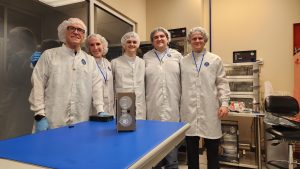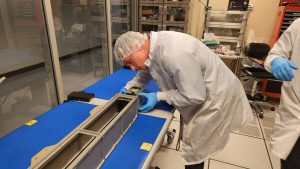12/12/2023
FOR IMMEDIATE RELEASE
DECEMBER 2023
(St. John’s, NL) – C-CORE, in partnership with Memorial University, have successfully delivered and integrated the Killick-1 CubeSat satellite into the Nanoracks launcher at the Canadian Space Agency (CSA).
On November 28th, Memorial University students Victoria Vaters, Daniel Dolomount, Matthew Fewer, Cameron King, and C-CORE’s VP of Remote Sensing, Desmond Power visited the CSA in Longueuil, Quebec where they successfully integrated the Killick-1 CubeSat satellite into the Nanoracks launcher. This step is a major milestone for the team’s Canadian CubeSat project.

Killick development team members Desmond Power, Victoria Vaters, Cameron King, Matthew Fewer and Daniel Dolomount
The Killick-1 Project is a joint project involving Memorial University’s Faculty of Engineering and Applied Science and C-CORE, funded by the CSA and The Government of Newfoundland & Labrador’s Department of Industry, Energy and Technology (IET). The co-principal investigator for the project is Dr. Weimin Huang of the Faculty of Engineering, Memorial University. The project has been supported by a large team of student supervisors at MUN, including Dr. Theo Norvell, Dr. Jon Anderson and Dr. Oscar De Silva. The team also had two additional industry advisors, including Dr. Robert Cove from Solace Power and Andre Pant from Xona Space Systems. The project involved some 130 student volunteers, work term students and graduate students and development has been ongoing since 2019.
The Killick-1 has a specialized payload designed to measure sea ice extent and ocean parameters. It is a radar that measures signals from GPS navigational satellites that reflect off the earth’s surface. The Killick-1 team chose that payload because of its relevance to Newfoundland and Labrador and the leadership in radar systems research demonstrated at Memorial University. The importance of this satellite has been heightened by changes in climatic conditions that required additional sensors to accurately measure ocean conditions.
While at CSA, the Killick team performed a vibration test to ensure that the satellite could withstand the intense journey on a SpaceX rocket to the International Space Station. Once the vibration test was complete, the Killick students performed a fit test of the satellite within the launcher. The launcher is a square metal frame that uses a spring to launch the satellite into space. The satellite has to fit smoothly within the frame so that launch can be achieved using the spring. Once that test passed, the Killick-1 satellite, along with two others from the University of New Brunswick and University of Sherbrooke, were integrated into the launcher.

Brendan Swanik from Nanoracks test fitting the Killick-1 satellite into the launcher
The launcher has since been shipped to the US by Nanoracks, where it will sit in a queue for a rocket launch. The ride to the International Space Station will likely occur in March on a SpaceX rocket. Once it reaches the Space Station, the satellites will be deployed by ISS Astronauts from a robotic arm.
“It has been a phenomenal journey to get us to this point,” says Des Power. “The students have done a fantastic job getting us to the end. They have shown their dedication and commitment to getting this across the line.”
“The satellite development has been an excellent teaching tool for students,” says Weimin Huang. “Not only are we showing undergraduate students how to build satellites, but we are also teaching graduate students about the science of radar systems and how these important tools can be used to measure critical ocean parameters related to climate change.”
“Students who have worked on this project like myself are so thankful for the opportunity,” says Victoria Vaters. “We learn about these topics in school, but actually implementing them in real-world application, and now even beyond to space applications is the experience of a lifetime. It’s so easy to be passionate about a project as captivating as this one. It has fuelled a desire to want to learn more.”
-30-
Media Contact:
Jared Remedios
Communications & Marketing Manager, C-CORE
Jared.remedios@c-core.ca
